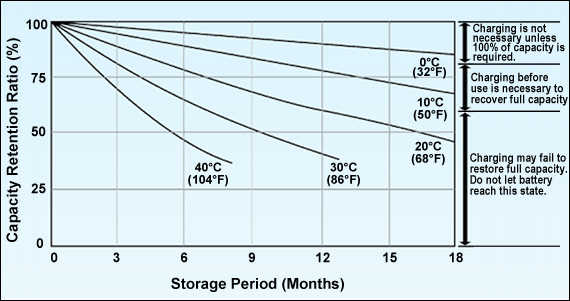According to lesson BU-808 at Battery University ( 25 C = 77 F) the biggest advantage of low temp storage occurs if you store batteries that are fully charged. Batteries stored at a 40% charge show little advantage in storage at low temperatures.
(Pasted from How to Prolong Lithium-based Batteries - Battery University)
Lithium-ion suffers from stress when exposed to heat, so does keeping a cell at a high charge voltage. A battery dwelling above 30°C (86°F) is considered elevated temperature and for most Li-ion a voltage above 4.10V/cell is deemed as high voltage. Exposing the battery to high temperature and dwelling in a full state-of-charge for an extended time can be more stressful than cycling. Table 3 demonstrates capacity loss as a function of temperature and SoC.
(Pasted from How to Prolong Lithium-based Batteries - Battery University)
Lithium-ion suffers from stress when exposed to heat, so does keeping a cell at a high charge voltage. A battery dwelling above 30°C (86°F) is considered elevated temperature and for most Li-ion a voltage above 4.10V/cell is deemed as high voltage. Exposing the battery to high temperature and dwelling in a full state-of-charge for an extended time can be more stressful than cycling. Table 3 demonstrates capacity loss as a function of temperature and SoC.
Temperature | 40% charge | 100% charge | Table 3: Estimated recoverable capacity when storing Li-ion for one year at various temperatures. Elevated temperature hastens permanent capacity loss. Not all Li-ion systems behave the same. |
| 0°C | 98% (after 1 year) | 94% (after 1 year) | |
| 25°C | 96% (after 1 year) | 80% (after 1 year) | |
| 40°C | 85% (after 1 year) | 65% (after 1 year) | |
| 60°C | 75% (after 1 year) | 60% (after 3 months) |
Last edited:














